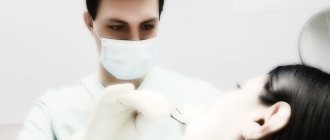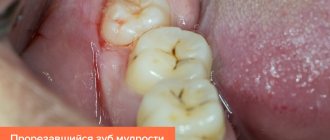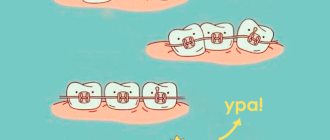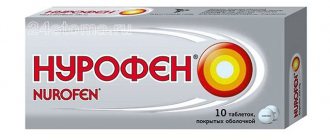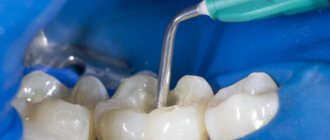What is the reason?
It is generally accepted that the cause of pain is caries. In fact, there are many more sources of pain. Therefore, when a child has a toothache, it is important to understand what caused it:
- pulpitis, periodontitis – inflammation of internal tissues;
- flux - inflammation of the periosteum;
- gingivitis – inflammation of the gums;
- abscess – accumulation of pus in the tissues surrounding the tooth;
- enamel erosion;
- ulcer on the mucous membrane;
- fistulas;
- caries.
With caries, the pain is usually paroxysmal, does not last long - up to several minutes, and occurs when eating cold or hot food. In case of pulpitis, periodontitis - acute, lasts for hours, is not relieved by painkillers, therefore the child needs help immediately.
Classification of dental diseases
Pathologies of teeth eruption and formation
Early detection of dental anomalies makes it easier to carry out subsequent bite correction. Irregularities in the sequence of eruption or asymmetry of opposing teeth should be a reason to contact an orthodontist. Diagnostic accuracy is ensured through x-ray examination.
Edentia
Characterized by partial or complete absence of teeth. The disease can be hereditary or develop throughout life. Sometimes the rudiments of teeth are completely absent from birth.
Supernumerary teeth (hyperdontia)
There are too many teeth in the mouth, and the extra ones can be located both in the dentition, disturbing the arrangement of the remaining teeth, and in atypical places - on the palate or on the front surface of the gums. The anomaly occurs in 5% of the population.
Impacted teeth
The teeth remain in the bone tissue of the jaw and do not erupt completely. In most cases, this is a disease of the molars - eights.
Dystopian teeth
The teeth are located in the wrong places in the jaw, at an angle, and only partially erupt. Pathology refers to diseases of wisdom teeth.
Macrodentia/Microdentia
An increase (or decrease) in the size of teeth compared to the standard norm.
Tooth enamel diseases
There are many chemical processes going on in the mouth that wear down the enamel. Under the influence of food containing dyes or acids, as well as cleaning products, the normal mineralization of teeth is disrupted. Pathologies of the endocrine system and work in hazardous industries are additional unfavorable factors.
Fluorosis
Damage caused by an excess of fluoride in consumed water or food. Fluorosis is commonly referred to as yellow tooth disease.
Enamel hypoplasia
A disease associated with impaired formation of the enamel structure. In most cases, it develops in the first nine months of a child's life.
Wedge-shaped defect
Formation of a “protrusion” at the neck of the tooth on the front side. A disease of the front teeth that can lead to chipping of the entire crown part.
Dental disease caries and its complications
Dental caries occurs in places where microbial plaque lingers and accumulates. The likelihood of developing the disease depends on the individual resistance of both dental tissues and the body as a whole. Resistance to caries is determined by the structure and composition of the enamel, the degree of its mineralization, as well as the characteristics of the dental system - the structure of the facial skeleton, jaws, bite and location of the teeth.
Caries
A pathology that develops in the hard tissues of the tooth, accompanied by demineralization of the enamel and the formation of a cavity. If left untreated, it provokes the development of inflammation in the pulp and periodontal tissues.
Pulpitis
Inflammation of the dental nerve. Characterized by acute pain radiating to the temples. May lead to tooth loss or exacerbation of periodontitis.
Periodontitis
The inflammatory process covers the apex of the tooth root. Without treatment, there is a risk of developing a cyst or abscess. The main manifestations are swelling of the gums, increased temperature.
Periostitis (flux)
Inflammation of the periosteum due to untreated periodontitis. Accompanied by swelling of the gums and severe pain.
Granuloma
Proliferation of inflammatory tissue in the area of the tooth root. Symptoms are redness and swelling of the gums, tooth pain. Ignoring the disease leads to the appearance of a cyst on the root of the tooth, fistula and diseases of the roots of the teeth.
Tooth cyst
A formation in the form of a capsule with pus at the apex of the tooth root, resulting from the penetration of infection into the root canals. The disease is asymptomatic, in some cases there is pain when chewing. The cyst is usually noticed on x-rays.
If you find signs of dental disease presented in the table, you must go to a dental clinic as soon as possible and consult a doctor. The specialist will examine the oral cavity, prescribe diagnostic procedures and draw up an optimal treatment plan for dental diseases to restore the health and beauty of your smile.
How to relieve pain if a child has a baby toothache
Before visiting a doctor, it is important to alleviate the baby’s suffering. Painkillers, which are always present in the home medicine cabinet of families with children, are suitable for this. If a 3-year-old child has a toothache, you can give one of these medications in an age-appropriate dosage:
- ibuprofen - the effect occurs after half an hour and lasts 6-8 hours;
- nimesulide - approved from two years of age, valid for up to 12 hours, presented in Nise or Nimesil tablets, however, this remedy is best used on the recommendation of a doctor;
- dental drops – suitable for older children.
Causes of dental diseases in humans
The main cause of dental diseases is the activity of bacteria, which results in caries. But there are other factors that affect oral health:
- heredity and genetic pathologies;
- quality of drinking water;
- ecology of the urban environment;
- nutritional features;
- professional activity.
In most cases, it is impossible to change anything from this list. Therefore, it is important to at least be able to promptly recognize the symptoms of dental disease and consult a doctor as soon as possible to avoid complications.
What should you not do if your child has a baby toothache?
If there is a cavity in the tooth, you should never put any medications inside, such as aspirin powder or pain-relieving drops. This can harm the child and lead to poisoning of the body. It is also forbidden to heat a sore tooth, as this can accelerate suppuration.
If the tooth stops hurting, you shouldn’t think that the problem has resolved itself. The acute process has become chronic, the destruction of tissue inside is progressing. There is an infection in the body that can lead to other pathological processes. Even with improvements, a visit to the dentist is mandatory!
Prevention of dental diseases
Some people are not even aware of what dental diseases with inflammatory processes and pathologies are provoked in other vital organs. For those who are not in the know, we inform you: these are gastritis, ulcers, tonsillitis, thrombosis, heart attack and stroke! And the pathogenic bacteria are to blame for everything, which, multiplying in the oral cavity, enter the throat, stomach, blood vessels and even the heart.
To prevent dental diseases, follow simple rules that will help significantly improve your oral health and overall well-being.
- Stop smoking.
A bad habit provokes vasoconstriction and deterioration of blood supply to the mucous membrane, which results in a lack of nutrients necessary for teeth and gums. - Eat a balanced diet.
The abundance of flour and sweet foods in the diet contributes to an excessive increase in microorganisms and inevitably leads to caries and its complications. Take care of strengthening your enamel by taking vitamin complexes. Then the disease when “teeth crumble”, which occurs due to a lack of calcium in the body, will not be scary for you. - Brush your teeth 2 times a day.
Regular hygiene is one of the most effective ways to keep your teeth safe and sound. In addition to the traditional use of brushes and pastes, you should not neglect dental floss. Flosses effectively remove food debris between the teeth, preventing the development of many diseases. - Get preventive examinations once every six months.
It is easier to cure any disease if it is detected at the beginning of its development. Some dental diseases in dentistry have symptoms that cannot be identified on their own. For example, caries at the junction of teeth is visible only on an x-ray.
A person is not able to influence factors that cause various types of dental diseases, such as poor ecology, heredity, and stress. However, with a responsible attitude towards hygiene and prevention, the risk of dental diseases can be significantly reduced or, at least, their treatment can be facilitated.
What to do if a 6 year old child has a toothache?
Folk remedies can bring temporary relief. The main thing is that they do not cause an allergic reaction (herbs, honey) and do not lead to gum burns (tinctures, garlic). Dosages should be minimal. Children 6 years and older benefit from rinsing the mouth at intervals of 2-3 hours. The solution (not hot) must be kept in the mouth for up to a minute. Suitable for these purposes:
- saline solution (a glass of water + a teaspoon of salt);
- soda solution (a glass of water + half a teaspoon of soda);
- a decoction of chamomile, sage, lemon balm, oak bark, mint or other medicinal herbs.
So, what to do if your child has toothache? First of all, don't panic! Make an appointment with a pediatric dentist. After taking painkillers and rinsing, the baby will feel better. To prevent the situation from getting worse, offer your son or daughter soft or semi-liquid food, do not give anything cold or hot, and ask him to rinse his mouth with warm water after each meal. These measures are quite enough to survive the period until a visit to the pediatric dentist. Keep calm - and it will definitely be passed on to your child!
Jokes about doctors and doctors
In the morning in the newspaper, in the evening in a verse... Three days ago in Philadelphia, a black guy with a long history of mental disorders experienced an exacerbation. The family called 911. The police arrived, he jumped out with a knife, did not respond to the police orders - they shot him. The crowd responded as usual by looting stores.
Almost 20 years ago. The hero of this story, Ross, was our neighbor, as well as my wife's colleague and most trusted friend. A native Texan—all his known ancestors were born and raised in Texas—he was the least like a Hollywood cowboy. Blonde, height 165-170, weight no more than 60. The wife is also not typical, a Spaniard from Spain, but a small, quiet, fair-haired girl. A couple of years later their daughter was born, so we almost never heard from her. Ross said that he once ran a marathon in under 4 hours and would like to do it again. Someday later, of course. Then they had another super-marathon - an internship in the surgical program of one of the New York hospitals. What this is is colorfully described in the book “The House of God,” or rather, as it was in the 70s. Morals have certainly softened over 30 years, there will be no tragedies in my history. But there remained humiliation and hazing and, most importantly, the schedule. One month I calculated that it was an average of 96 working hours per week. The explanation is simple: a resident is already a doctor (MD is written on his badge), and he is paid 2-3 times less than a nurse and 5-10 times less than a real doctor. Nurses also have a trade union.
This happened during their practice in the heart of the Bronx. When they say that there are two zoos in the Bronx, one inside the fence and the other outside, these are about those places. I went there a couple of times - there are more police officers in the hospital than medical staff. At night, tough guys bring corpses and seriously wounded people to the entrance. You can often see young guys in wheelchairs. I asked the locals what kind of epidemic this was. It turned out that these were guilty gang members. They are shot humanely in the spine so that the bullet does not hit important organs. Fun area. But not everything is so simple in the city of contrasts, New York - at night they sometimes went out to have a bite to eat at a nearby 24-hour eatery and did not even think that it could be dangerous. Probably, their scrubs (uniforms) protected them - more reliable than any guards and body armor.
Patients after surgery, when anesthesia wears off, experience psychosis. This is not uncommon, especially for drug addicts, and staff are usually prepared for this. But here the patient was extraordinary. They say he looks like Tyson, but the size of Shaquille O'Neal. And very boisterous. The nurse entered the room and immediately jumped out. I consulted with my friends and decided to call the police. A police lady arrived, breathing heavily, of normal height and about the same weight as the patient. Looking into the room, she made a wise verdict: this man is dangerous, and he needs to be tied to the bed. She agrees to handcuff him herself and read him his rights, but...first he must get an injection and calm down. By this time a small crowd had gathered outside the chamber and everyone was looking at each other. Oh!, suddenly it dawned on the first nurse - we have a young doctor on duty right now. We called the doctor. Ross was in the final hours of his 36-hour workday. -Doctor, the patient needs to be sedated, but, you see, doctor... -Syringe! , the doctor interrupted the story and extended his hand. They put a syringe in him and made way. The brute stood up to meet him, humming and rolling his eyes, and loomed over the boyish figure of the doctor. The peeping sisters and the courageous police lady closed their eyes. Ross put his hand on King Kong's shoulder and pressed lightly. The patient obediently sat down on the bed and sat motionless while he was given an injection. Then the doctor gave him some cotton wool and asked him to press it with his finger, touched his forehead - the patient lay down and quickly fell asleep.
And there was day, and there was night, and a new day, and a new watch. Ross was greeted with applause, slapped on the shoulder, and asked for details. Ross could not help them in any way - the entire episode was completely erased from his memory.
PS A couple of years ago we drove through this area. At a traffic light I get distracted and don’t turn green right away. Crossing our path, a white Hummer rushes by. The car sparkles with multi-colored lights, and deafening rap sounds from the open windows. Nothing happened, but they thought about the eternal. -You know, if something happens to me on the road, and you can influence where they take me, let them take me here. -Here?! Why not Columbia? You were happy there, told me how wonderful your colleagues and teachers are, you still sometimes call them on business. Well, in general, Columbia is a global name. - Yes, they are, indeed, very smart, they read all the articles, write themselves, and speak at conferences. But here, in trauma, surgeons are simply putting people together piece by piece every day. 24 hours a day.

